Greggs Plc: Managing Financial Resources and Decision Making Report
VerifiedAdded on 2020/01/15
|9
|2491
|163
Report
AI Summary
This report provides a detailed analysis of the financial management practices of Greggs Plc, a prominent bakery chain in the United Kingdom. It begins with an overview of the company's products and services, followed by an examination of the various costing methods employed, including job costing, process costing, and batch costing, with a specific focus on how these methods are applicable to Greggs' operations. The report then classifies the costs associated with the production and sale of sandwiches and J20 juice, differentiating between direct, indirect, variable, and fixed costs. The pricing strategy of Greggs is evaluated, highlighting its approach to covering costs and achieving profit margins. Furthermore, the report includes a calculation of the unit cost of sandwiches using a marginal costing approach and analyzes the break-even point. The impact of price fluctuations on the company's products and services is also discussed, considering factors such as competition and market conditions. The report concludes that Greggs Plc employs effective financial management strategies, particularly in its costing and pricing approaches.
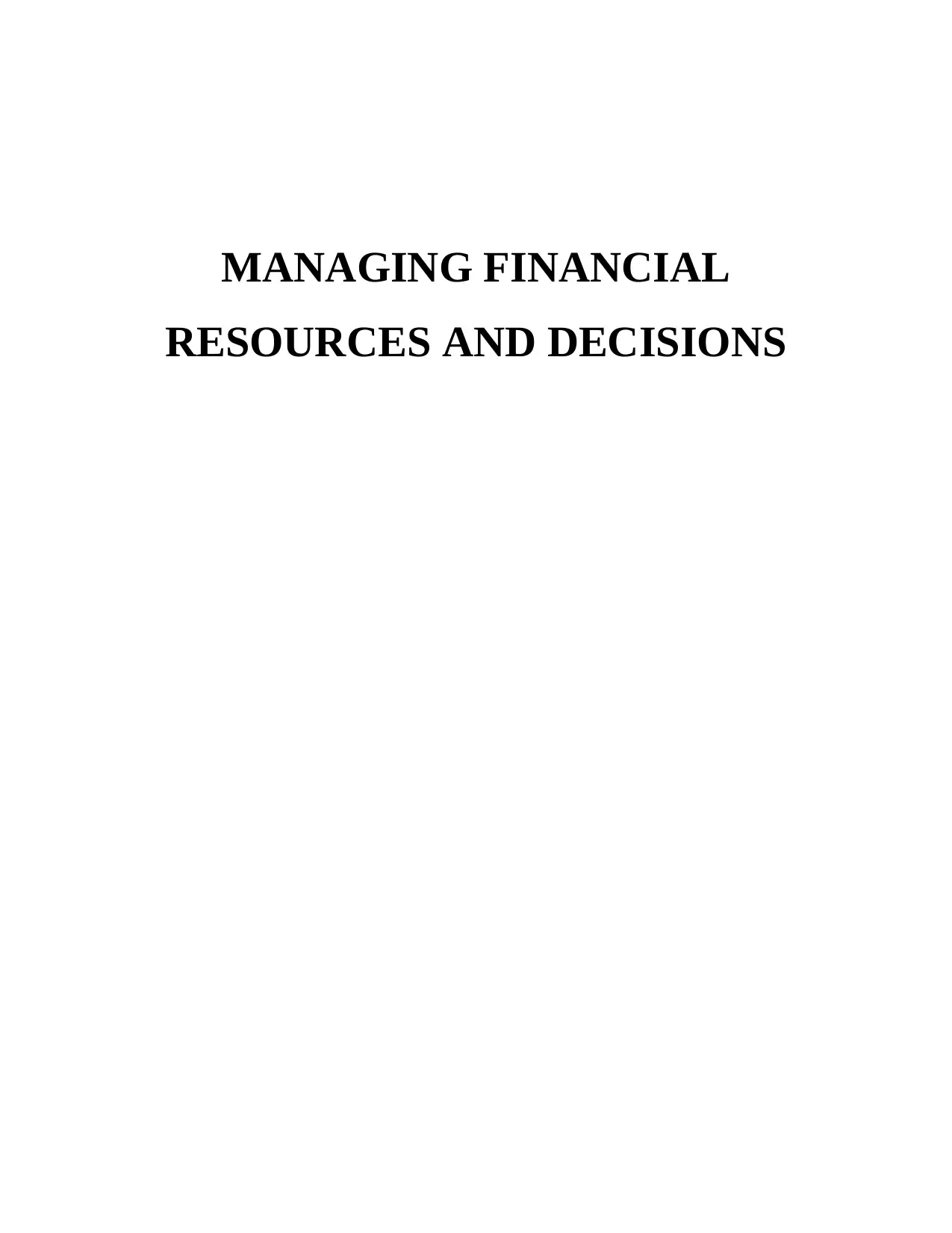
MANAGING FINANCIAL
RESOURCES AND DECISIONS
RESOURCES AND DECISIONS
Paraphrase This Document
Need a fresh take? Get an instant paraphrase of this document with our AI Paraphraser
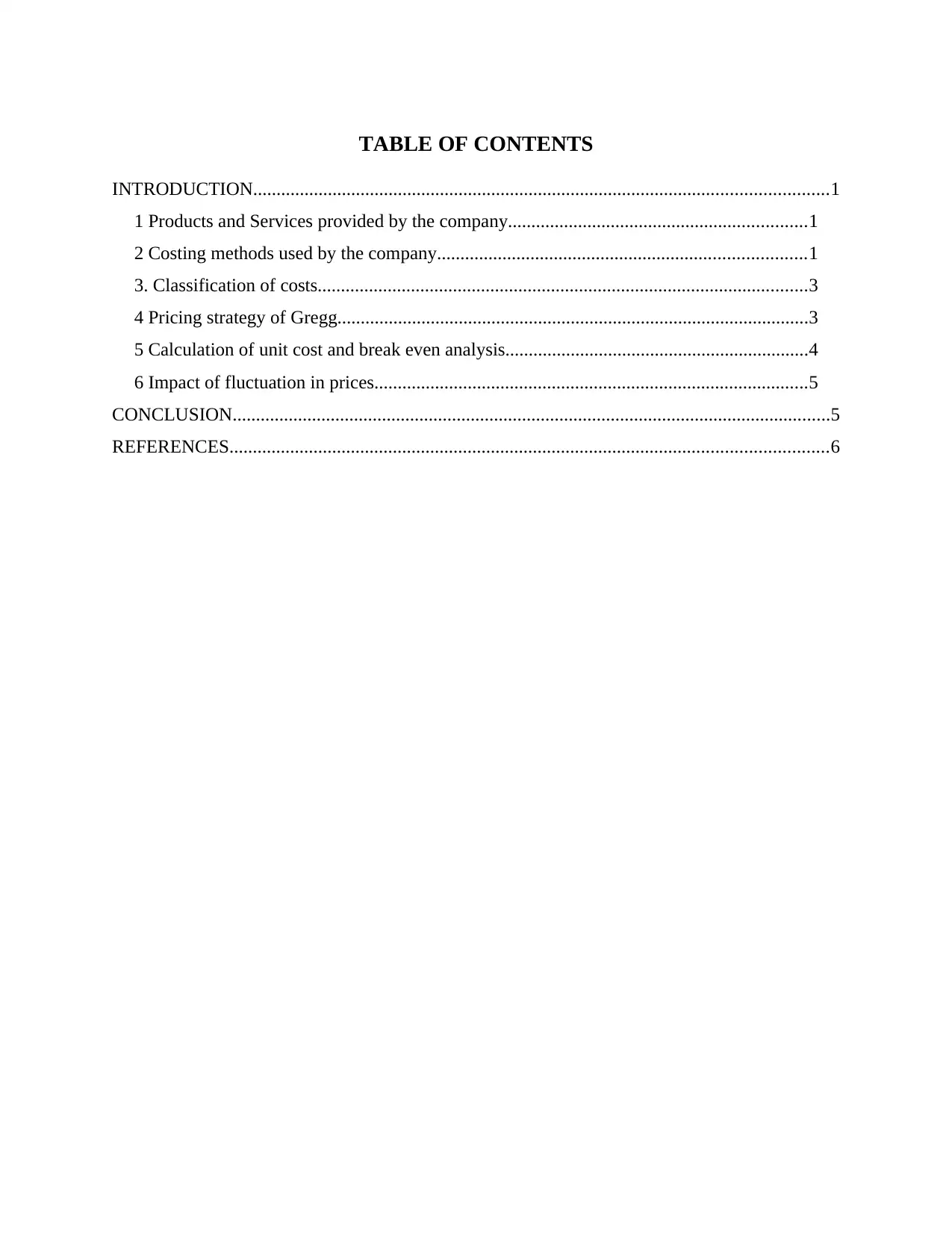
TABLE OF CONTENTS
INTRODUCTION...........................................................................................................................1
1 Products and Services provided by the company................................................................1
2 Costing methods used by the company...............................................................................1
3. Classification of costs.........................................................................................................3
4 Pricing strategy of Gregg.....................................................................................................3
5 Calculation of unit cost and break even analysis.................................................................4
6 Impact of fluctuation in prices.............................................................................................5
CONCLUSION................................................................................................................................5
REFERENCES................................................................................................................................6
INTRODUCTION...........................................................................................................................1
1 Products and Services provided by the company................................................................1
2 Costing methods used by the company...............................................................................1
3. Classification of costs.........................................................................................................3
4 Pricing strategy of Gregg.....................................................................................................3
5 Calculation of unit cost and break even analysis.................................................................4
6 Impact of fluctuation in prices.............................................................................................5
CONCLUSION................................................................................................................................5
REFERENCES................................................................................................................................6

INTRODUCTION
A good financial management plays a very important role in success, survival and
sustainability of an organisation. Financial decision-making directly affects business of a
company whether it is a small company or a big company. Financial management helps in
making financial decisions by evaluating resources and provides information that can be used in
planning and assessing its impact on the organisation. In the given scenario, the financial
resources of Greggs plc and the implication of those financial resources within the organisation
have been discussed. Costing methods, classification of costs and the factors influencing the
price setting are also taken into consideration.
1 Products and Services provided by the company
Gregg Plc is famous for its bakery in United Kingdom. It provides variety of food in
menu like pasties and bakes, sandwiches, sweet, pasta, salads and soup, bread, platters and drinks
and snacks etc. The services offered by this bakery are different from those of other bakeries, as
several units are opened at different places so the customers is not required to not visit the main
building of Greggs Bakery, for availing the bakery services (Blocher, Chen and Lin, 2008). The
product delivery and other services provided by the mentioned company are very much
appreciated by customers and they have created a brand value in the market. The food served to
customers is always prepared at the time when they make order thus they do not offer already
prepared food. It is the USP of this bakery that it takes care of the customers and provides them
with the best quality food.
2 Costing methods used by the company
There are various costing methods which can be used by the said company to manage
their financial resources. These are job costing, process costing, and batch costing, contract
costing, unit costing, operating costing, multiple costing, service costing etc. (Hansen, Mowen
and Guan, 2007). A brief description about the given costing techniques is as follow:
1. Job Costing: To identify the cost of different jobs or work orders a method is used that is
known as job costing. In this method, costs are allocated to different jobs. The bakery can
use this method for different jobs like cost of purchasing a raw material to prepare food,
cost of equipments used in cooking, cost allocated to customer services and counter
1
A good financial management plays a very important role in success, survival and
sustainability of an organisation. Financial decision-making directly affects business of a
company whether it is a small company or a big company. Financial management helps in
making financial decisions by evaluating resources and provides information that can be used in
planning and assessing its impact on the organisation. In the given scenario, the financial
resources of Greggs plc and the implication of those financial resources within the organisation
have been discussed. Costing methods, classification of costs and the factors influencing the
price setting are also taken into consideration.
1 Products and Services provided by the company
Gregg Plc is famous for its bakery in United Kingdom. It provides variety of food in
menu like pasties and bakes, sandwiches, sweet, pasta, salads and soup, bread, platters and drinks
and snacks etc. The services offered by this bakery are different from those of other bakeries, as
several units are opened at different places so the customers is not required to not visit the main
building of Greggs Bakery, for availing the bakery services (Blocher, Chen and Lin, 2008). The
product delivery and other services provided by the mentioned company are very much
appreciated by customers and they have created a brand value in the market. The food served to
customers is always prepared at the time when they make order thus they do not offer already
prepared food. It is the USP of this bakery that it takes care of the customers and provides them
with the best quality food.
2 Costing methods used by the company
There are various costing methods which can be used by the said company to manage
their financial resources. These are job costing, process costing, and batch costing, contract
costing, unit costing, operating costing, multiple costing, service costing etc. (Hansen, Mowen
and Guan, 2007). A brief description about the given costing techniques is as follow:
1. Job Costing: To identify the cost of different jobs or work orders a method is used that is
known as job costing. In this method, costs are allocated to different jobs. The bakery can
use this method for different jobs like cost of purchasing a raw material to prepare food,
cost of equipments used in cooking, cost allocated to customer services and counter
1
⊘ This is a preview!⊘
Do you want full access?
Subscribe today to unlock all pages.

Trusted by 1+ million students worldwide
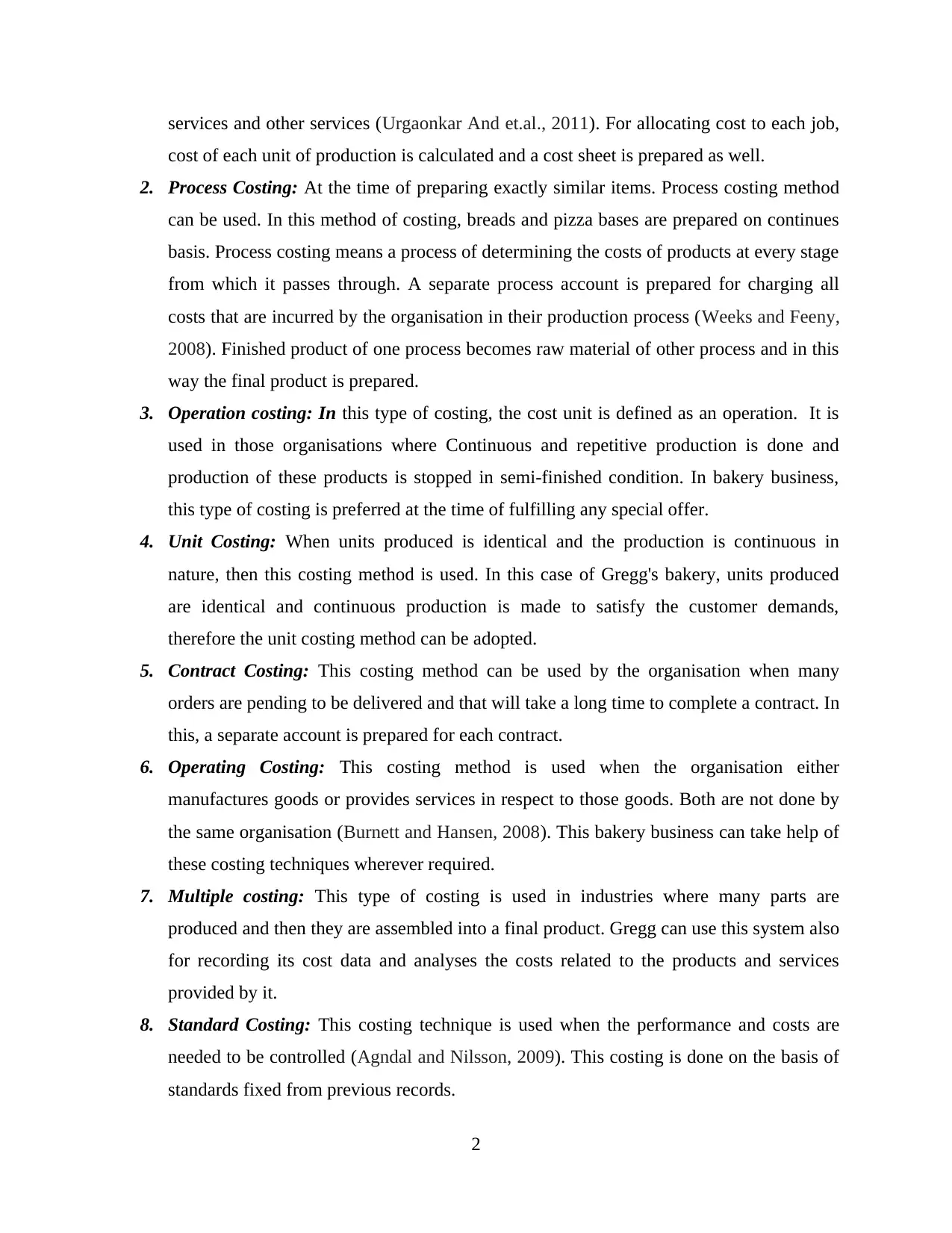
services and other services (Urgaonkar And et.al., 2011). For allocating cost to each job,
cost of each unit of production is calculated and a cost sheet is prepared as well.
2. Process Costing: At the time of preparing exactly similar items. Process costing method
can be used. In this method of costing, breads and pizza bases are prepared on continues
basis. Process costing means a process of determining the costs of products at every stage
from which it passes through. A separate process account is prepared for charging all
costs that are incurred by the organisation in their production process (Weeks and Feeny,
2008). Finished product of one process becomes raw material of other process and in this
way the final product is prepared.
3. Operation costing: In this type of costing, the cost unit is defined as an operation. It is
used in those organisations where Continuous and repetitive production is done and
production of these products is stopped in semi-finished condition. In bakery business,
this type of costing is preferred at the time of fulfilling any special offer.
4. Unit Costing: When units produced is identical and the production is continuous in
nature, then this costing method is used. In this case of Gregg's bakery, units produced
are identical and continuous production is made to satisfy the customer demands,
therefore the unit costing method can be adopted.
5. Contract Costing: This costing method can be used by the organisation when many
orders are pending to be delivered and that will take a long time to complete a contract. In
this, a separate account is prepared for each contract.
6. Operating Costing: This costing method is used when the organisation either
manufactures goods or provides services in respect to those goods. Both are not done by
the same organisation (Burnett and Hansen, 2008). This bakery business can take help of
these costing techniques wherever required.
7. Multiple costing: This type of costing is used in industries where many parts are
produced and then they are assembled into a final product. Gregg can use this system also
for recording its cost data and analyses the costs related to the products and services
provided by it.
8. Standard Costing: This costing technique is used when the performance and costs are
needed to be controlled (Agndal and Nilsson, 2009). This costing is done on the basis of
standards fixed from previous records.
2
cost of each unit of production is calculated and a cost sheet is prepared as well.
2. Process Costing: At the time of preparing exactly similar items. Process costing method
can be used. In this method of costing, breads and pizza bases are prepared on continues
basis. Process costing means a process of determining the costs of products at every stage
from which it passes through. A separate process account is prepared for charging all
costs that are incurred by the organisation in their production process (Weeks and Feeny,
2008). Finished product of one process becomes raw material of other process and in this
way the final product is prepared.
3. Operation costing: In this type of costing, the cost unit is defined as an operation. It is
used in those organisations where Continuous and repetitive production is done and
production of these products is stopped in semi-finished condition. In bakery business,
this type of costing is preferred at the time of fulfilling any special offer.
4. Unit Costing: When units produced is identical and the production is continuous in
nature, then this costing method is used. In this case of Gregg's bakery, units produced
are identical and continuous production is made to satisfy the customer demands,
therefore the unit costing method can be adopted.
5. Contract Costing: This costing method can be used by the organisation when many
orders are pending to be delivered and that will take a long time to complete a contract. In
this, a separate account is prepared for each contract.
6. Operating Costing: This costing method is used when the organisation either
manufactures goods or provides services in respect to those goods. Both are not done by
the same organisation (Burnett and Hansen, 2008). This bakery business can take help of
these costing techniques wherever required.
7. Multiple costing: This type of costing is used in industries where many parts are
produced and then they are assembled into a final product. Gregg can use this system also
for recording its cost data and analyses the costs related to the products and services
provided by it.
8. Standard Costing: This costing technique is used when the performance and costs are
needed to be controlled (Agndal and Nilsson, 2009). This costing is done on the basis of
standards fixed from previous records.
2
Paraphrase This Document
Need a fresh take? Get an instant paraphrase of this document with our AI Paraphraser
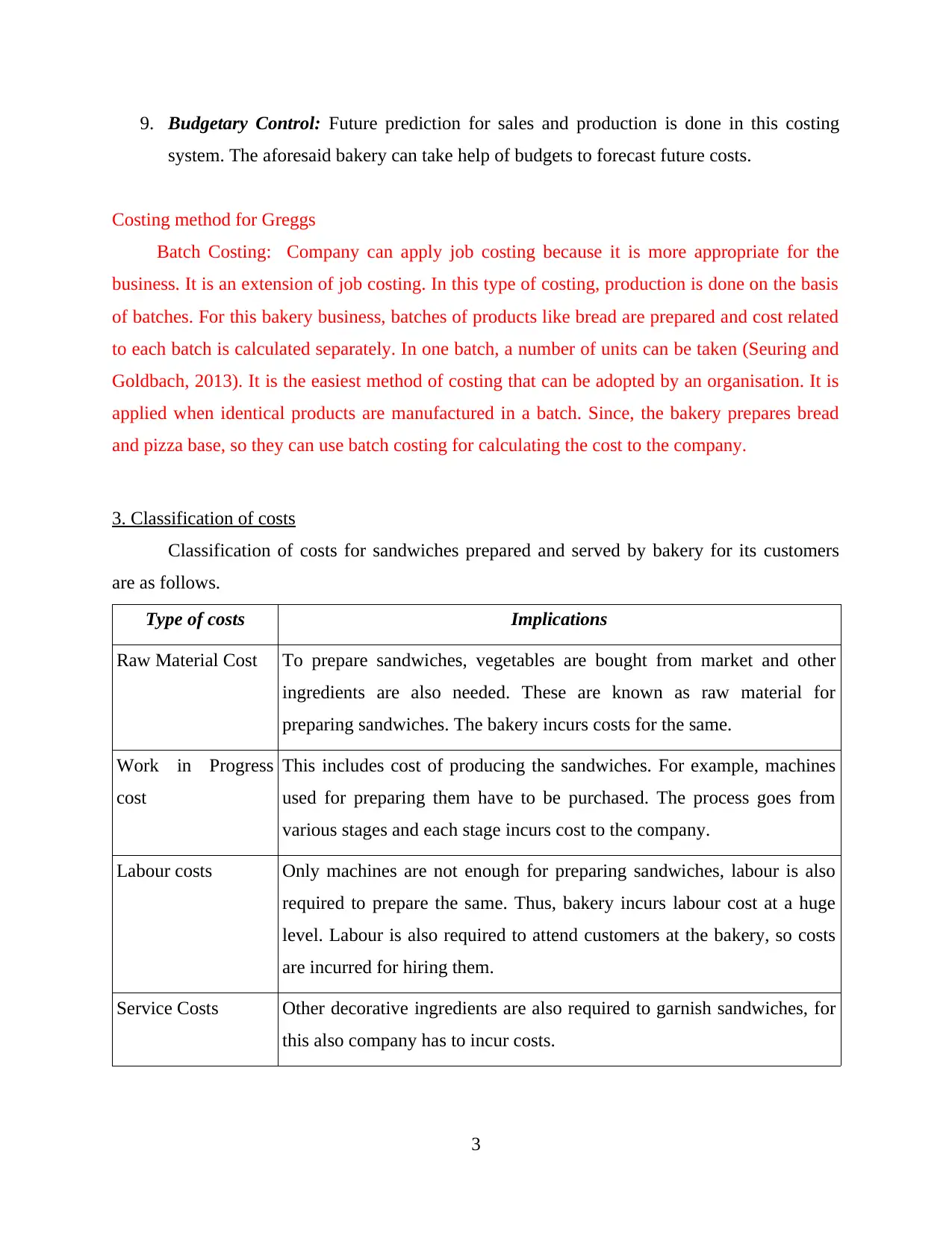
9. Budgetary Control: Future prediction for sales and production is done in this costing
system. The aforesaid bakery can take help of budgets to forecast future costs.
Costing method for Greggs
Batch Costing: Company can apply job costing because it is more appropriate for the
business. It is an extension of job costing. In this type of costing, production is done on the basis
of batches. For this bakery business, batches of products like bread are prepared and cost related
to each batch is calculated separately. In one batch, a number of units can be taken (Seuring and
Goldbach, 2013). It is the easiest method of costing that can be adopted by an organisation. It is
applied when identical products are manufactured in a batch. Since, the bakery prepares bread
and pizza base, so they can use batch costing for calculating the cost to the company.
3. Classification of costs
Classification of costs for sandwiches prepared and served by bakery for its customers
are as follows.
Type of costs Implications
Raw Material Cost To prepare sandwiches, vegetables are bought from market and other
ingredients are also needed. These are known as raw material for
preparing sandwiches. The bakery incurs costs for the same.
Work in Progress
cost
This includes cost of producing the sandwiches. For example, machines
used for preparing them have to be purchased. The process goes from
various stages and each stage incurs cost to the company.
Labour costs Only machines are not enough for preparing sandwiches, labour is also
required to prepare the same. Thus, bakery incurs labour cost at a huge
level. Labour is also required to attend customers at the bakery, so costs
are incurred for hiring them.
Service Costs Other decorative ingredients are also required to garnish sandwiches, for
this also company has to incur costs.
3
system. The aforesaid bakery can take help of budgets to forecast future costs.
Costing method for Greggs
Batch Costing: Company can apply job costing because it is more appropriate for the
business. It is an extension of job costing. In this type of costing, production is done on the basis
of batches. For this bakery business, batches of products like bread are prepared and cost related
to each batch is calculated separately. In one batch, a number of units can be taken (Seuring and
Goldbach, 2013). It is the easiest method of costing that can be adopted by an organisation. It is
applied when identical products are manufactured in a batch. Since, the bakery prepares bread
and pizza base, so they can use batch costing for calculating the cost to the company.
3. Classification of costs
Classification of costs for sandwiches prepared and served by bakery for its customers
are as follows.
Type of costs Implications
Raw Material Cost To prepare sandwiches, vegetables are bought from market and other
ingredients are also needed. These are known as raw material for
preparing sandwiches. The bakery incurs costs for the same.
Work in Progress
cost
This includes cost of producing the sandwiches. For example, machines
used for preparing them have to be purchased. The process goes from
various stages and each stage incurs cost to the company.
Labour costs Only machines are not enough for preparing sandwiches, labour is also
required to prepare the same. Thus, bakery incurs labour cost at a huge
level. Labour is also required to attend customers at the bakery, so costs
are incurred for hiring them.
Service Costs Other decorative ingredients are also required to garnish sandwiches, for
this also company has to incur costs.
3

Classifying costs for J20 juice
Cost Element Direct Function Behaviour
Ingredients Material Direct
cost
Operations Variable
cost
Employees Labor Direct
cost
Operations Variable
cost
Advertising Expense Indirect
cost
Marketing Fixed
Accounting Expense Indirect
cost
Finance Fixed
Electricity Expense Indirect
cost
People Fixed
Rent Expense Indirect
cost
All Fixed
Deliveries Expense Indirect
costs
Operations Variable
Packaging Material Direct
cost
Operations Variable
4 Pricing strategy of Gregg
The reason behind Gregg's leading position in the bakery market is its strategy to provide
food on go basis to their customers. They have made facility to provide their products at
supermarkets, coffee shops and fast food operators. The Greggs brand has covered the entire
market by showing good values, giving fresh and tasty products and best customer services. It
provides savoury and fully enchanting breakfasts and sandwiches to its customers and this is
4
Cost Element Direct Function Behaviour
Ingredients Material Direct
cost
Operations Variable
cost
Employees Labor Direct
cost
Operations Variable
cost
Advertising Expense Indirect
cost
Marketing Fixed
Accounting Expense Indirect
cost
Finance Fixed
Electricity Expense Indirect
cost
People Fixed
Rent Expense Indirect
cost
All Fixed
Deliveries Expense Indirect
costs
Operations Variable
Packaging Material Direct
cost
Operations Variable
4 Pricing strategy of Gregg
The reason behind Gregg's leading position in the bakery market is its strategy to provide
food on go basis to their customers. They have made facility to provide their products at
supermarkets, coffee shops and fast food operators. The Greggs brand has covered the entire
market by showing good values, giving fresh and tasty products and best customer services. It
provides savoury and fully enchanting breakfasts and sandwiches to its customers and this is
4
⊘ This is a preview!⊘
Do you want full access?
Subscribe today to unlock all pages.

Trusted by 1+ million students worldwide
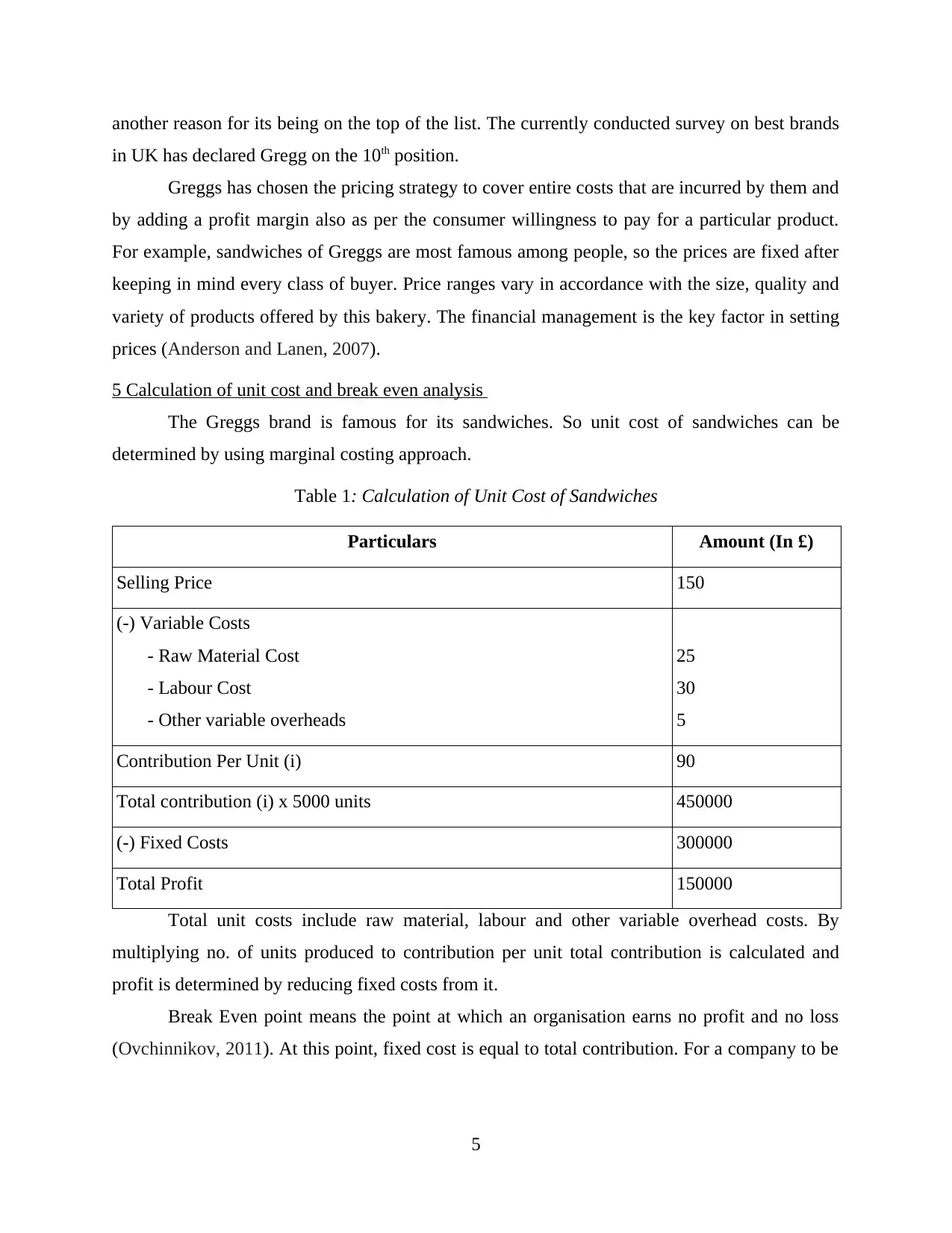
another reason for its being on the top of the list. The currently conducted survey on best brands
in UK has declared Gregg on the 10th position.
Greggs has chosen the pricing strategy to cover entire costs that are incurred by them and
by adding a profit margin also as per the consumer willingness to pay for a particular product.
For example, sandwiches of Greggs are most famous among people, so the prices are fixed after
keeping in mind every class of buyer. Price ranges vary in accordance with the size, quality and
variety of products offered by this bakery. The financial management is the key factor in setting
prices (Anderson and Lanen, 2007).
5 Calculation of unit cost and break even analysis
The Greggs brand is famous for its sandwiches. So unit cost of sandwiches can be
determined by using marginal costing approach.
Table 1: Calculation of Unit Cost of Sandwiches
Particulars Amount (In £)
Selling Price 150
(-) Variable Costs
- Raw Material Cost
- Labour Cost
- Other variable overheads
25
30
5
Contribution Per Unit (i) 90
Total contribution (i) x 5000 units 450000
(-) Fixed Costs 300000
Total Profit 150000
Total unit costs include raw material, labour and other variable overhead costs. By
multiplying no. of units produced to contribution per unit total contribution is calculated and
profit is determined by reducing fixed costs from it.
Break Even point means the point at which an organisation earns no profit and no loss
(Ovchinnikov, 2011). At this point, fixed cost is equal to total contribution. For a company to be
5
in UK has declared Gregg on the 10th position.
Greggs has chosen the pricing strategy to cover entire costs that are incurred by them and
by adding a profit margin also as per the consumer willingness to pay for a particular product.
For example, sandwiches of Greggs are most famous among people, so the prices are fixed after
keeping in mind every class of buyer. Price ranges vary in accordance with the size, quality and
variety of products offered by this bakery. The financial management is the key factor in setting
prices (Anderson and Lanen, 2007).
5 Calculation of unit cost and break even analysis
The Greggs brand is famous for its sandwiches. So unit cost of sandwiches can be
determined by using marginal costing approach.
Table 1: Calculation of Unit Cost of Sandwiches
Particulars Amount (In £)
Selling Price 150
(-) Variable Costs
- Raw Material Cost
- Labour Cost
- Other variable overheads
25
30
5
Contribution Per Unit (i) 90
Total contribution (i) x 5000 units 450000
(-) Fixed Costs 300000
Total Profit 150000
Total unit costs include raw material, labour and other variable overhead costs. By
multiplying no. of units produced to contribution per unit total contribution is calculated and
profit is determined by reducing fixed costs from it.
Break Even point means the point at which an organisation earns no profit and no loss
(Ovchinnikov, 2011). At this point, fixed cost is equal to total contribution. For a company to be
5
Paraphrase This Document
Need a fresh take? Get an instant paraphrase of this document with our AI Paraphraser
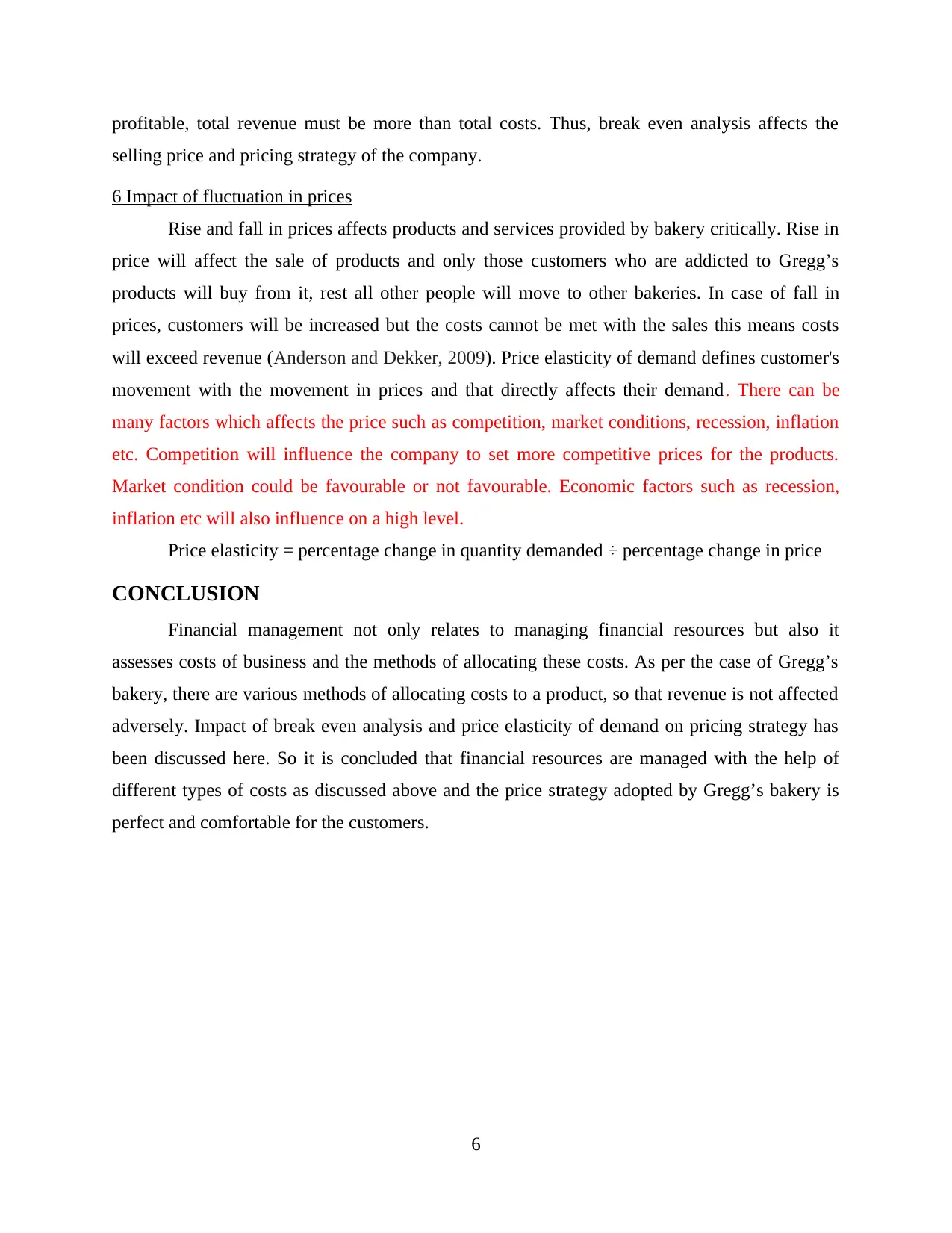
profitable, total revenue must be more than total costs. Thus, break even analysis affects the
selling price and pricing strategy of the company.
6 Impact of fluctuation in prices
Rise and fall in prices affects products and services provided by bakery critically. Rise in
price will affect the sale of products and only those customers who are addicted to Gregg’s
products will buy from it, rest all other people will move to other bakeries. In case of fall in
prices, customers will be increased but the costs cannot be met with the sales this means costs
will exceed revenue (Anderson and Dekker, 2009). Price elasticity of demand defines customer's
movement with the movement in prices and that directly affects their demand. There can be
many factors which affects the price such as competition, market conditions, recession, inflation
etc. Competition will influence the company to set more competitive prices for the products.
Market condition could be favourable or not favourable. Economic factors such as recession,
inflation etc will also influence on a high level.
Price elasticity = percentage change in quantity demanded ÷ percentage change in price
CONCLUSION
Financial management not only relates to managing financial resources but also it
assesses costs of business and the methods of allocating these costs. As per the case of Gregg’s
bakery, there are various methods of allocating costs to a product, so that revenue is not affected
adversely. Impact of break even analysis and price elasticity of demand on pricing strategy has
been discussed here. So it is concluded that financial resources are managed with the help of
different types of costs as discussed above and the price strategy adopted by Gregg’s bakery is
perfect and comfortable for the customers.
6
selling price and pricing strategy of the company.
6 Impact of fluctuation in prices
Rise and fall in prices affects products and services provided by bakery critically. Rise in
price will affect the sale of products and only those customers who are addicted to Gregg’s
products will buy from it, rest all other people will move to other bakeries. In case of fall in
prices, customers will be increased but the costs cannot be met with the sales this means costs
will exceed revenue (Anderson and Dekker, 2009). Price elasticity of demand defines customer's
movement with the movement in prices and that directly affects their demand. There can be
many factors which affects the price such as competition, market conditions, recession, inflation
etc. Competition will influence the company to set more competitive prices for the products.
Market condition could be favourable or not favourable. Economic factors such as recession,
inflation etc will also influence on a high level.
Price elasticity = percentage change in quantity demanded ÷ percentage change in price
CONCLUSION
Financial management not only relates to managing financial resources but also it
assesses costs of business and the methods of allocating these costs. As per the case of Gregg’s
bakery, there are various methods of allocating costs to a product, so that revenue is not affected
adversely. Impact of break even analysis and price elasticity of demand on pricing strategy has
been discussed here. So it is concluded that financial resources are managed with the help of
different types of costs as discussed above and the price strategy adopted by Gregg’s bakery is
perfect and comfortable for the customers.
6
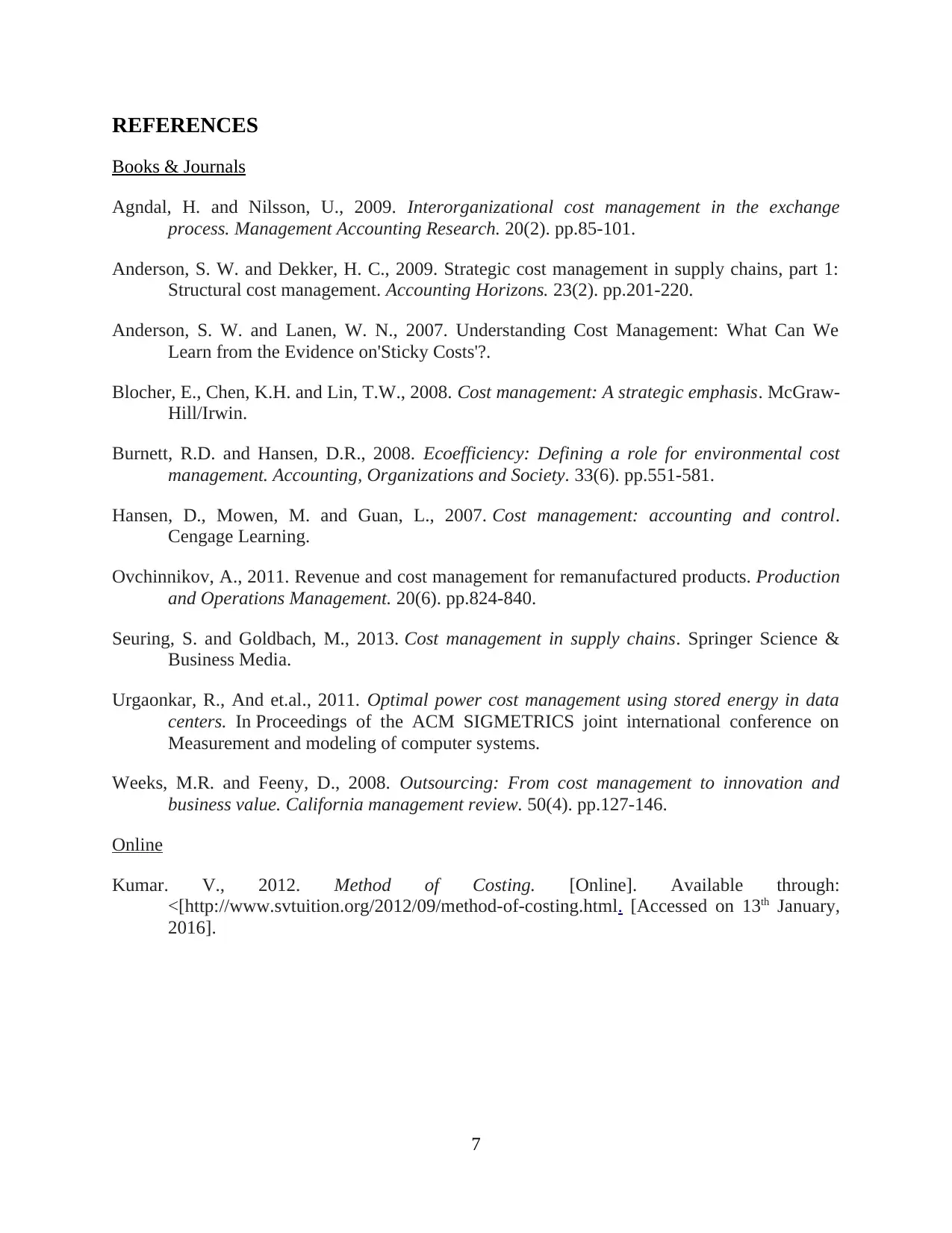
REFERENCES
Books & Journals
Agndal, H. and Nilsson, U., 2009. Interorganizational cost management in the exchange
process. Management Accounting Research. 20(2). pp.85-101.
Anderson, S. W. and Dekker, H. C., 2009. Strategic cost management in supply chains, part 1:
Structural cost management. Accounting Horizons. 23(2). pp.201-220.
Anderson, S. W. and Lanen, W. N., 2007. Understanding Cost Management: What Can We
Learn from the Evidence on'Sticky Costs'?.
Blocher, E., Chen, K.H. and Lin, T.W., 2008. Cost management: A strategic emphasis. McGraw-
Hill/Irwin.
Burnett, R.D. and Hansen, D.R., 2008. Ecoefficiency: Defining a role for environmental cost
management. Accounting, Organizations and Society. 33(6). pp.551-581.
Hansen, D., Mowen, M. and Guan, L., 2007. Cost management: accounting and control.
Cengage Learning.
Ovchinnikov, A., 2011. Revenue and cost management for remanufactured products. Production
and Operations Management. 20(6). pp.824-840.
Seuring, S. and Goldbach, M., 2013. Cost management in supply chains. Springer Science &
Business Media.
Urgaonkar, R., And et.al., 2011. Optimal power cost management using stored energy in data
centers. In Proceedings of the ACM SIGMETRICS joint international conference on
Measurement and modeling of computer systems.
Weeks, M.R. and Feeny, D., 2008. Outsourcing: From cost management to innovation and
business value. California management review. 50(4). pp.127-146.
Online
Kumar. V., 2012. Method of Costing. [Online]. Available through:
<[http://www.svtuition.org/2012/09/method-of-costing.html. [Accessed on 13th January,
2016].
7
Books & Journals
Agndal, H. and Nilsson, U., 2009. Interorganizational cost management in the exchange
process. Management Accounting Research. 20(2). pp.85-101.
Anderson, S. W. and Dekker, H. C., 2009. Strategic cost management in supply chains, part 1:
Structural cost management. Accounting Horizons. 23(2). pp.201-220.
Anderson, S. W. and Lanen, W. N., 2007. Understanding Cost Management: What Can We
Learn from the Evidence on'Sticky Costs'?.
Blocher, E., Chen, K.H. and Lin, T.W., 2008. Cost management: A strategic emphasis. McGraw-
Hill/Irwin.
Burnett, R.D. and Hansen, D.R., 2008. Ecoefficiency: Defining a role for environmental cost
management. Accounting, Organizations and Society. 33(6). pp.551-581.
Hansen, D., Mowen, M. and Guan, L., 2007. Cost management: accounting and control.
Cengage Learning.
Ovchinnikov, A., 2011. Revenue and cost management for remanufactured products. Production
and Operations Management. 20(6). pp.824-840.
Seuring, S. and Goldbach, M., 2013. Cost management in supply chains. Springer Science &
Business Media.
Urgaonkar, R., And et.al., 2011. Optimal power cost management using stored energy in data
centers. In Proceedings of the ACM SIGMETRICS joint international conference on
Measurement and modeling of computer systems.
Weeks, M.R. and Feeny, D., 2008. Outsourcing: From cost management to innovation and
business value. California management review. 50(4). pp.127-146.
Online
Kumar. V., 2012. Method of Costing. [Online]. Available through:
<[http://www.svtuition.org/2012/09/method-of-costing.html. [Accessed on 13th January,
2016].
7
⊘ This is a preview!⊘
Do you want full access?
Subscribe today to unlock all pages.

Trusted by 1+ million students worldwide
1 out of 9
Related Documents
Your All-in-One AI-Powered Toolkit for Academic Success.
+13062052269
info@desklib.com
Available 24*7 on WhatsApp / Email
![[object Object]](/_next/static/media/star-bottom.7253800d.svg)
Unlock your academic potential
Copyright © 2020–2025 A2Z Services. All Rights Reserved. Developed and managed by ZUCOL.




